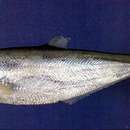en
names in breadcrumbs


Ilisha is a genus of ray-finned fishes in the family Pristigasteridae. The genus contains 16 species. It is similar to Pellona but lacks a toothed hypo-maxilla. The genus has a worldwide distribution in tropical and subtropical coastal waters and estuaries.[1] Some species also enter rivers, and I. amazonica and I. novacula are largely–if not entirely–restricted to tropical rivers.[2][3]
Two Ilisha species are individually reported in the FAO catch statistics: Ilisha elongata off coasts of China and Korea and Ilisha africana off West African coasts.[4] Other species may be reported as simply clupeoids.
There are currently 16 recognized species in this genus:[5]
Ilisha is a genus of ray-finned fishes in the family Pristigasteridae. The genus contains 16 species. It is similar to Pellona but lacks a toothed hypo-maxilla. The genus has a worldwide distribution in tropical and subtropical coastal waters and estuaries. Some species also enter rivers, and I. amazonica and I. novacula are largely–if not entirely–restricted to tropical rivers.